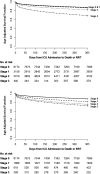Classifying AKI by Urine Output versus Serum Creatinine Level
- PMID: 25568178
- PMCID: PMC4552117
- DOI: 10.1681/ASN.2014070724
Classifying AKI by Urine Output versus Serum Creatinine Level
Abstract
Severity of AKI is determined by the magnitude of increase in serum creatinine level or decrease in urine output. However, patients manifesting both oliguria and azotemia and those in which these impairments are persistent are more likely to have worse disease. Thus, we investigated the relationship of AKI severity and duration across creatinine and urine output domains with the risk for RRT and likelihood of renal recovery and survival using a large, academic medical center database of critically ill patients. We analyzed electronic records from 32,045 patients treated between 2000 and 2008, of which 23,866 (74.5%) developed AKI. We classified patients by levels of serum creatinine and/or urine output according to Kidney Disease Improving Global Outcomes staging criteria for AKI. In-hospital mortality and RRT rates increased from 4.3% and 0%, respectively, for no AKI to 51.1% and 55.3%, respectively, when serum creatinine level and urine output both indicated stage 3 AKI. Both short- and long-term outcomes were worse when patients had any stage of AKI defined by both criteria. Duration of AKI was also a significant predictor of long-term outcomes irrespective of severity. We conclude that short- and long-term risk of death or RRT is greatest when patients meet both the serum creatinine level and urine output criteria for AKI and when these abnormalities persist.
Keywords: ARF; dialysis; mortality.
Copyright © 2015 by the American Society of Nephrology.
Figures




References
-
- Palevsky PM, Molitoris BA, Okusa MD, Levin A, Waikar SS, Wald R, Chertow GM, Murray PT, Parikh CR, Shaw AD, Go AS, Faubel SG, Kellum JA, Chinchilli VM, Liu KD, Cheung AK, Weisbord SD, Chawla LS, Kaufman JS, Devarajan P, Toto RM, Hsu CY, Greene T, Mehta RL, Stokes JB, Thompson AM, Thompson BT, Westenfelder CS, Tumlin JA, Warnock DG, Shah SV, Xie Y, Duggan EG, Kimmel PL, Star RA: Design of clinical trials in acute kidney injury: Report from an NIDDK workshop on trial methodology. Clin J Am Soc Nephrol 7: 844–850, 2012 - PubMed
-
- Okusa MD, Molitoris BA, Palevsky PM, Chinchilli VM, Liu KD, Cheung AK, Weisbord SD, Faubel S, Kellum JA, Wald R, Chertow GM, Levin A, Waikar SS, Murray PT, Parikh CR, Shaw AD, Go AS, Chawla LS, Kaufman JS, Devarajan P, Toto RM, Hsu CY, Greene TH, Mehta RL, Stokes JB, Thompson AM, Thompson BT, Westenfelder CS, Tumlin JA, Warnock DG, Shah SV, Xie Y, Duggan EG, Kimmel PL, Star RA: Design of clinical trials in acute kidney Injury: A report from an NIDDK workshop–prevention trials. Clin J Am Soc Nephrol 7: 851–855, 2012 - PubMed
-
- Molitoris BA, Okusa MD, Palevsky PM, Chawla LS, Kaufman JS, Devarajan P, Toto RM, Hsu CY, Greene TH, Faubel SG, Kellum JA, Wald R, Chertow GM, Levin A, Waikar SS, Murray PT, Parikh CR, Shaw AD, Go AS, Chinchilli VM, Liu KD, Cheung AK, Weisbord SD, Mehta RL, Stokes JB, Thompson AM, Thompson BT, Westenfelder CS, Tumlin JA, Warnock DG, Shah SV, Xie Y, Duggan EG, Kimmel PL, Star RA: Design of clinical trials in AKI: A report from an NIDDK workshop. Trials of patients with sepsis and in selected hospital settings. Clin J Am Soc Nephrol 7: 856–860, 2012 - PubMed
Publication types
MeSH terms
Substances
Grants and funding
LinkOut - more resources
Full Text Sources
Other Literature Sources
Medical

